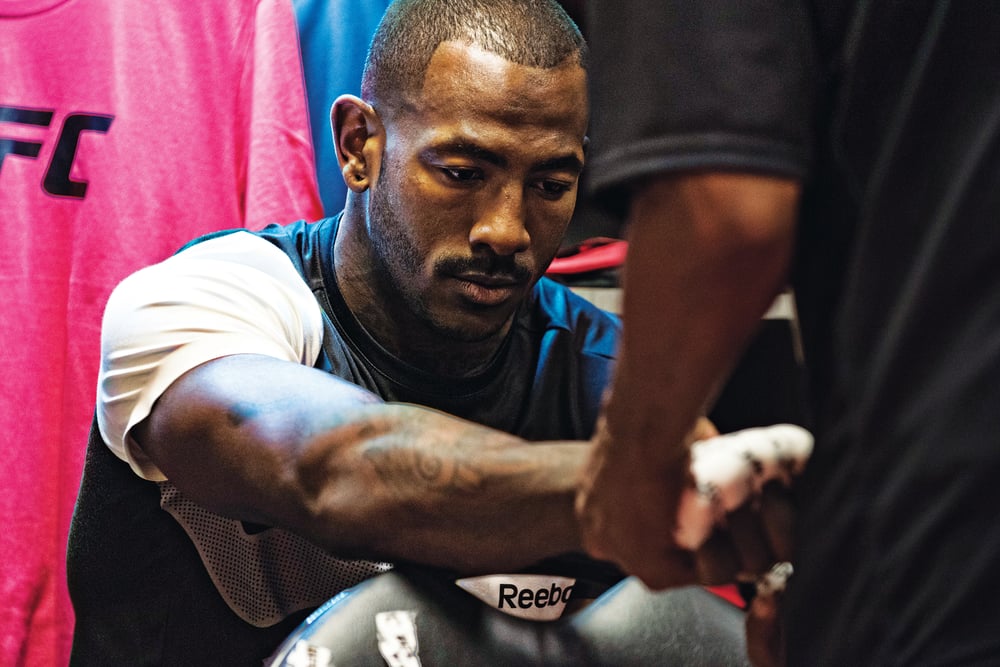
Issue 161
December 2017
Khalil Rountree takes the smart approach to unleash explosive Octagon power
What does your strength training program look like?
My conditioning coach is an ex-military instructor. He would do survival school for paratroopers, where they learned how to survive in the worst conditions possible; borderline death. You are defending our country, you are in the middle of nowhere and you have to get the mission done. He has kids who are athletes and knows a lot about the human body. I run mountains and push myself on the bike, just going and going and going until I want to stop. Then, he tells me I can go for two more hours…
How much of the conditioning game is mental?
I would say the sport is 70% mental. I meditate a lot, read philosophy books and quotes. I am immersed in motivational topics, old spiritual works from the Dalai Lama and anybody who understands life. I put these teachings into experience for myself. I want to understand what I am: what can I do? What are my limitations? I am not really finding many. As far as physical conditioning goes, I do a lot of normal things: a lot of running, pull-ups – just doing normal exercises. I don’t want my body to get too big or too small. I just want to get strong.
Are you always looking for new techniques and methods, or do you try and keep things simple?
I have done a lot of it before and I see the benefit in it, but I want to be able to do things that are really hard. I want to be able to stand from the sitting position – just whip my legs around and get up. That is something nobody would train, but imagine if you possess the strength to do that. People would be like, ‘Holy s**t!’ Or jumping out of the pool to dry land effortlessly. Or to be able to squat in position and not wobble. I want my body to have no limits in movement. That’s my main focus. If I can move my body with strength in any direction, try to hold me down. It will be a hell of a night for sure.

How do you approach nutrition when you’re preparing for a fight?
I eat a lot. I eat real food, real good food. Right now, I am about to eat steak, broccoli and rice – and a lot of it. I used to eat so little that I wasn’t providing enough gas and I wouldn’t have the energy to burn the next day. Now I am eating so much, so that I can constantly stay active. Right now, I can eat a huge meal and have enough energy to go for a five-mile run tonight. If I am eating a little bit because I am watching my weight, I can’t do that. The more I eat the more gas I burn, so I can work out five times a day if I want to. I eat a lot – and I eat real food.
What does your total technique schedule consist of at Syndicate MMA?
As far as striking goes, I do a 30-minute pad session with John Wood – punching, kicking, etc. Then I come right into MMA practice, so whatever I learned with John, I will implement in the standup session of the MMA class. Then it’s straight to grappling.
How often do you have a breakthrough where something in training clicks and you add it to the arsenal?
Every day. Every day I train striking there is something new that I come up with, a new way of doing things or a new way of setting something up. That’s because I love it so much and I am always looking for something new in that area.
How much of your time is spent training on the ground?
It’s three or four days a week of all of the above. If there is a wrestling class, I am doing the whole hour. If there is a jiu-jitsu class, I am taking it. Then we implement it into MMA. We are very MMA-focused here. Everything is about doing it for an equal amount of time: striking for an hour, wrestling for an hour, jiu-jitsu for an hour. It’s all about consistency. Minimum four days, maximum five to six days a week. I am just learning. I am not going to become a purple belt overnight, but if I can defend against them, that will help me excel a little bit faster.
...









